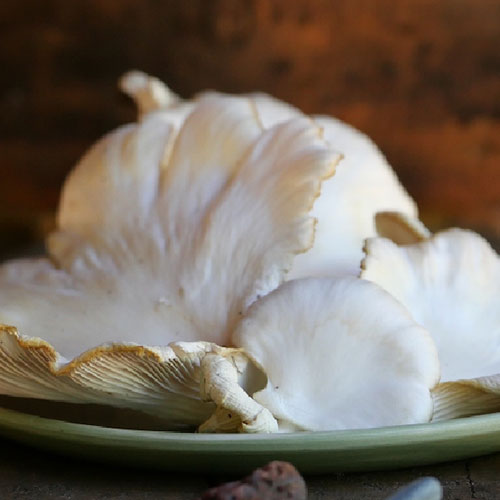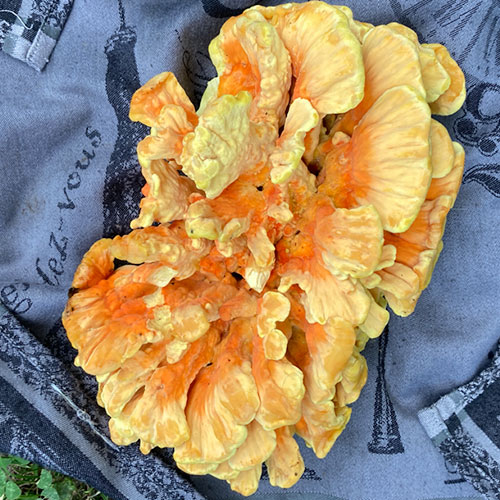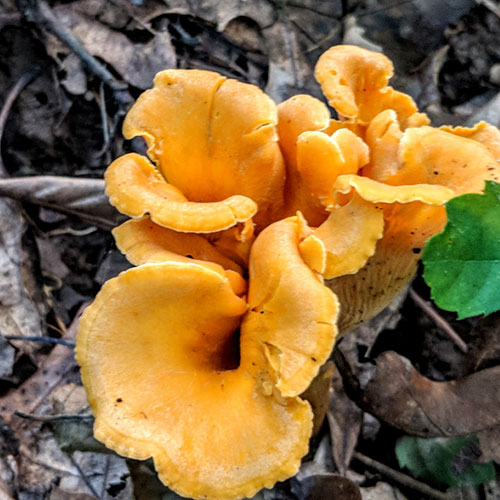There’s a rhythm to the heartland woods in the summer. It’s in the dripping of rain, the subtle taste of pollen on your lips, the fresh, hot summer air filling your lungs, and the cicadas shrieking in your ears. It includes the rise of a wonderful variety of edible plants and mushrooms that all creatures can enjoy. Some of our greatest-hits mushrooms appear during our hottest months: the underrated (and abused) giant puffball, the apricot-scented chanterelle, and the neon-colored chicken of the woods, all of them a thrill to find.
Giant puffball (Calvatia gigantea)
Stop curb-stomping puffballs, y’all. This is a fairly common mushroom, so there’s a good chance you’ve seen one before—or at least one obliterated on the side of a trail. The puffball is an amazing tofu substitute and just one specimen can feed you for days. Look for large, smooth, white balls, like volleyballs without the markings, along treelines.
It always helps to cut these open to be sure the interior is pure white. Any yellowing on the inside of the mushroom is a sign of spore development, which is toxic to humans. There are no toxic lookalikes to the giant puffball, only the barely-too-old specimens that are yellow on the inside, or the mature mushrooms that blow spores out the top when you poke them. When you have found your bright white puffball, wipe it clean and cook it thoroughly. Whether you toss it in a stir fry, sauté it with scrambled eggs, or slice, marinate, and grill it like a steak, its mildly soft and soy-like texture can please anyone.
Chanterelle (Cantharellus sp.)
I was playing disc golf when I found my first chanterelles. (I heaped them onto my disc and left the game behind, claiming victory of a different kind.) This mushroom is a fine-dining staple. It grows abundantly in hot, rainy conditions, often in the grass alongside oak, maple, and other hardwood trees in older forests or close to streams. Chants love low, moist, shady sloped areas. Look for bright, yellow-orange pops of color on the forest floor.
Chanterelles almost always grow individually, not in clusters, though they can be close together, and they never grow on wood. They have smooth caps that flatten out and curl upward with age. On the underside of a chanterelle, you’ll see ridges, not true gills. To further confirm that you have the right mushroom, pull the stem apart. The inside should be white, with a texture like string cheese, and you should pick up a light, earthy apricot aroma.
The flavor compounds in chanterelles are fat-soluble, which means that these mushrooms truly shine when cooked in cream or butter (or vegan alternatives) and served on pasta or on toast. Most recently, I threw a handful into a basic homemade gravy, easily kicking it up ten fancy points. Keep your preparation simple to highlight the mushroom’s stone fruit and pepper flavors.
Chicken of the woods (Laetiporus sp.)
Yes, it does taste like chicken. You’ll typically find this relatively common and coveted mushroom on decaying logs, though it can also grow on buried roots and even living trees, sprouting single or overlapping neon-yellow-and-orange fans. These mushrooms grow up high, down low, and nearly anywhere else they can squeeze out of deciduous trees. (It is not recommended to harvest these mushrooms from evergreens.)
You can use them just like chicken, in every way. Slice it and bread them for mushie tenders or smoke them for a wild-harvested barbecue dinner. The first time I found a chicken of the woods, I was sweating my way through a summer backpacking trip with my wife. Fortunately, I always keep an extra nylon sack with me, and I already had cooking oil and kosher salt packed in my backpacking cooking kit. I cut only what we could eat for one meal from the newest, softest sections, bagged it, and sautéed it on my camp stove for lunch. It was the perfect (and free) meal to keep us going another couple miles.
As always, be triple sure on your identification and use multiple resources to verify your haul before you feed anybody you love—including yourself!




